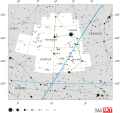The Zeta Perseids (ζ–Perseids) are a daylight meteor shower that takes place from about May 20 to July 5. On the peak date of June 13, the radiant is...
3 KB (140 words) - 03:24, 7 January 2021
The daytime showers are active from May to July (Beta Taurids and Zeta Perseids), while the nighttime showers are active from September to December...
15 KB (1,429 words) - 03:32, 24 November 2023
July 2 each year, and peaks on June 7. The Arietids, along with the Zeta Perseids, are the most intense daylight meteor showers of the year. The source...
6 KB (375 words) - 21:35, 16 September 2022
Lyrids May 5 – 6: Eta Aquariids June 9 – 10: Arietids & zeta-Perseids August 12 – 13: Perseids October 21 – 22: Orionids November 3 – 5: Taurids November...
30 KB (4,082 words) - 10:24, 16 May 2024
two other more active daytime meteor showers are known. They are the Zeta Perseids which are also related to Taurid complex and the Arietids which are...
7 KB (636 words) - 12:56, 9 April 2023
Monocerotids Normids (gamma Normids) Orionids Pegasids Perseids Daytime zeta Perseids September epsilon Perseids Phoenicids (July Phoenicids) Piscis Austrinids...
815 bytes (71 words) - 18:47, 11 July 2023
250 million light-years from Earth. It hosts the radiant of the annual Perseids meteor shower—one of the most prominent meteor showers in the sky. In Greek...
45 KB (5,201 words) - 18:31, 22 June 2024
October 6 and October 15. They may be related to the September Epsilon Perseids, though they are more similar to the Coma Berenicids in that the Delta...
95 KB (10,465 words) - 18:59, 3 July 2024
stem library, https://github.com/perseusdl/morpheus https://github.com/perseids-tools/beta-code-rb/tree/master/vendor/beta-code-json Paul Hardy, beta2uni...
7 KB (553 words) - 15:18, 12 July 2024
letter by Bayer and is a suspected variable with a very small amplitude. Zeta Cassiopeiae (Fulu) is a suspected slowly pulsating B-type star. Eta Cassiopeiae...
39 KB (4,720 words) - 19:36, 27 June 2024




